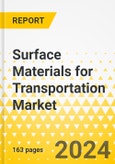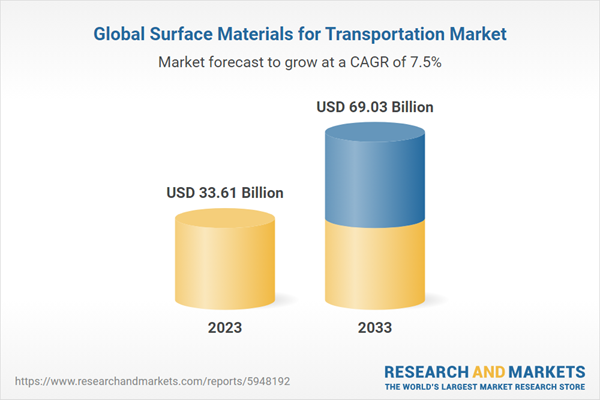This report comes with 10% free customization, enabling you to add data that meets your specific business needs.
The demand for surface materials for the transportation market such as upholstery, dashboards, headliners, and others is anticipated to grow with the increasing demand from end-use industries such as automotive, marine, aviation, rail, and among others. Furthermore, it is anticipated that during the projected period, i.e., 2023-2033, the increasing adoption of surface materials in the automotive industry in several advanced economies, including the U.S., Canada, Germany, France, Italy, China, India, among others, are expected to further increase the advancement of the global surface materials for the transportation market. However, the escalating emphasis on the demand for aftermarket customer modification acts as a key driving force behind the increasing demand for surface materials such as fabrics, natural leather, synthetic leather, and non-wovens, among others, and the surge in vehicle production significantly affects the growth of the global surface materials for the transportation market. However, in a price-sensitive market, increasing installation costs and fluctuation in raw material prices can hinder consumer adoption and act as a challenge in the global surface material for transportation market.
Market Lifecycle Stage
The surface materials for the transportation market are in the growth phase. The market is propelled by the growing customer interest in vehicle personalization and is expected to boost the market. Furthermore, high demand from end-use industries and governments' emphasis on sustainability in all sectors increases the demand for sustainable surface materials such as, recycled materials, plant-based materials, bio-based materials, and others, thereby bolstering the global surface materials for the transportation market. Moreover, the surface materials for transportation market is expected to benefit from the expansion of manufacturing facilities in emerging markets, which represents a strategic move that holds immense potential for advanced economies in the surface materials for transportation market.
Industrial Impact
Surface materials offer numerous advantages. It provides an excellent opportunity for automotive manufacturers to elevate themselves with the use of advanced fabrics, natural leather, synthetic leather among others in various applications such as upholstery, dashboard, headliner, and others. Furthermore, surface materials can made into smart materials by embedding them with sensors or other materials that can respond to stimuli, for example, synthetic leather could be made to change color in response to changes in temperature, or it could be made to become more conductive in the presence of moisture. various surfaces, facilitating consistent and visually attractive advertisements. In the same vein, renowned for its durability, surface materials offer a resilient solution for vehicle interiors and exteriors. Surface materials offer a transformative solution for building industries by providing aesthetic designs for designers to enhance their creativity. Furthermore, the adaptability of surface materials allows the creation of dynamic and changeable surface elements.
Market Segmentation:
Segmentation 1: by Application
- Upholstery
- Headliner
- Dashboard
- Others
The upholstery leads the global surface materials for the transportation market.
Segmentation 2: by Sales Channel
- OEM
- Aftermarket
The surface material for the transportation market is estimated to be led by the OEM segment in terms of the sales channel.
Segmentation 3: by End-Use Industry
- Automotive
- Marine
- Aviation
- Rail
The surface material for the transportation market is estimated to be led by automotive in terms of the end-use industry.
Segmentation 4: by Material Type
- Vinyl
- Leather
- Fabric
- Other Sustainable Alternatives
The surface material for the transportation market is estimated to be led by leather in terms of material type.
Segmentation 5: by Region
- North America - U.S., Canada, and Mexico
- Europe - Germany, France, U.K., Italy, and Rest-of-Europe
- Asia-Pacific - China, Japan, Australia, South Korea, India, and Rest-of-Asia-Pacific
- Rest-of-the-World - Brazil, U.A.E., and Others-of-Rest-of-the-World
In the surface materials for the transportation market, Asia-Pacific is anticipated to gain traction in terms of production and adoption, owing to the continuous growth of surface materials such as natural leather, synthetic leather, and fabric, among others, and North America is anticipated to have a presence of key manufacturers in the region.
Recent Developments in the Global Surface Materials for Transportation Market
- In April 11, 2023 - Teijin Frontier Co., Ltd., the Teijin Group's fibers and products converting company, announced that it has developed an eco-friendly staple polyester nanofiber that offers excellent performance to reinforce rubber uses in products including automotive hoses belts, and others.
- In November 10, 2023 - Covestro, a materials manufacturer, has established a worldwide collaboration with Xinquan Automotive, a China automotive trim company, during the China International Import Expo held in Shanghai. The partnership aims to bolster business operations in China while fostering global cooperation, thereby facilitating Xinquan's entry into North America, Europe, and ASEAN nations. Broadening their technical partnership, Covestro and Xinquan will leverage Covestro’s extensive global research and development resources to create low-carbon polyurethane solutions for automotive interiors. This initiative involves incorporating partially bio-based raw materials into the manufacturing process.
- In February 17, 2022 - Teijin Limited announced that it has launched a lightweight, strong and cost-effective carbon fiber woven fabric developed with the company’s proprietary tow-spreading technology.
- In November 15, 2021 - Covestro and voxeljet announce a partnership to advance additive manufacturing in series production. Materials company Covestro and industrial 3D printer manufacturer voxeljet are collaborating to develop a material-machine combination for economic large series additive manufacturing.
Demand - Drivers and Challenges
The following are the demand drivers for the global surface material for the transportation market:
- Increase in Demand for Aftermarket Customer Modifications
- Increase in Vehicle Production
The surface materials for the transportation market are expected to face some limitations as well due to the following challenges:
- High Material and Installation Cost
- Increase in Regulations for Materials
How can this report add value to an organization?
Product/Innovation Strategy: The product segment helps the reader understand the different surface materials, various sales channels such as OEM and aftermarket, end-use industries, and different material types involved in the production of surface materials. Moreover, the study provides the reader with a detailed understanding of the surface materials for the transportation market based on the end user (automotive, marine, aviation, rail, and others).
Growth/Marketing Strategy: The surface materials for transportation market has seen major development by key players operating in the market, such as business expansions, partnerships, collaborations, mergers and acquisitions, and joint ventures. The favored strategy for the companies has been product developments, business expansions, and acquisitions to strengthen their position in the global surface materials for transportation market. For instance, Covestro, a materials manufacturer, has established a worldwide collaboration with Xinquan Automotive, a China automotive trim company, during the China International Import Expo held in Shanghai.
Competitive Strategy: Key players in the surface materials for transportation market analyzed and profiled in the study involve surface materials manufacturers and the overall ecosystem. Moreover, a detailed competitive benchmarking of the players operating in the surface materials for the transportation market has been done to help the reader understand how players stack against each other, presenting a clear market landscape. Additionally, comprehensive competitive strategies such as partnerships, agreements, acquisitions, and collaborations will aid the reader in understanding the untapped revenue pockets in the market.
Key Market Players and Competition Synopsis
The companies that are profiled have been selected based on input gathered from primary experts, analyzing company coverage, product portfolio, and market penetration.
The surface materials for transportation market has been segmented based on material type, among which leather accounted for around 44.1%, fabric around 38.0%, vinyl held around 9.8%, and other sustainable alternatives held for approximately 8.1% of the total surface materials consumed in the year 2022 in terms of value.
Some of the prominent names in the market are:
Company Type 1 (by Material Type): Vinyl
- Sekisui Chemical Co., Ltd
- Covestro
- Continental
- Kuraray Co. Ltd.
Company Type 2 (by Material Type): Leather
- MILLIKEN & COMPANY
- Toray Industries, Inc.
- Teijin Limited
- Sekisui Chemical Co., Ltd.
- Autostop Aviation
- Covestro
- Continental
- Kuraray Co. Ltd.
- BASF SE
Company Type 3 (by Material Type): Fabric
- Lydall Gutsche GmbH & Co. KG
- Toray Limited, Inc.
- Autostop Aviation
- Schoellar Textil AG
- MIKO srl
- Covestro
- Roger Corporation
- INVISTA
Company Type 4 (by Material Type): Other Sustainable Alternatives
- Teijin Limited
- BASF SE
- Infinited Fiber Company
- Continental
- Covestro
- MIKO srl
Companies that are not a part of the aforementioned pool have been well represented across different sections of the report (wherever applicable).
This product will be delivered within 3-5 business days.
Table of Contents
Companies Mentioned
- Lydall Gutsche GmbH & Co. KG
- Milliken & Company
- Toray Industries, Inc.
- Teijin Limited
- Sekisui Chemical Co., Ltd.
- AUTOSTOP AVIATION
- Schoeller Textil AG
- MIKO srl
- Covestro AG
- Continental AG
- Rogers Corporation
- INVISTA
- Kuraray Co. Ltd.
- BASF SE
- Infinited Fiber Company
Table Information
| Report Attribute | Details |
|---|---|
| No. of Pages | 163 |
| Published | March 2024 |
| Forecast Period | 2023 - 2033 |
| Estimated Market Value ( USD | $ 33.61 Billion |
| Forecasted Market Value ( USD | $ 69.03 Billion |
| Compound Annual Growth Rate | 7.4% |
| Regions Covered | Global |
| No. of Companies Mentioned | 15 |









